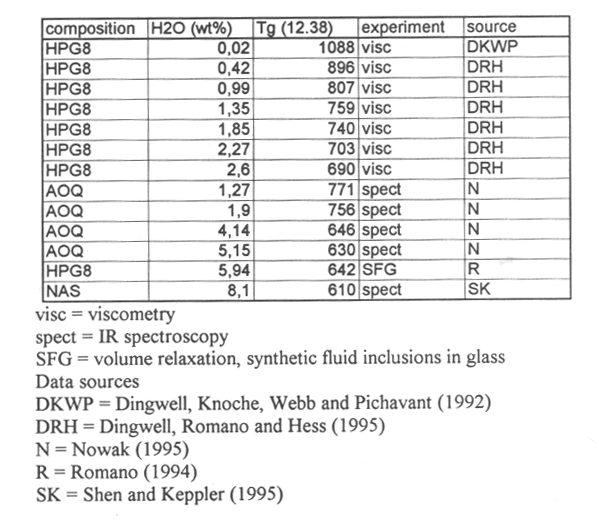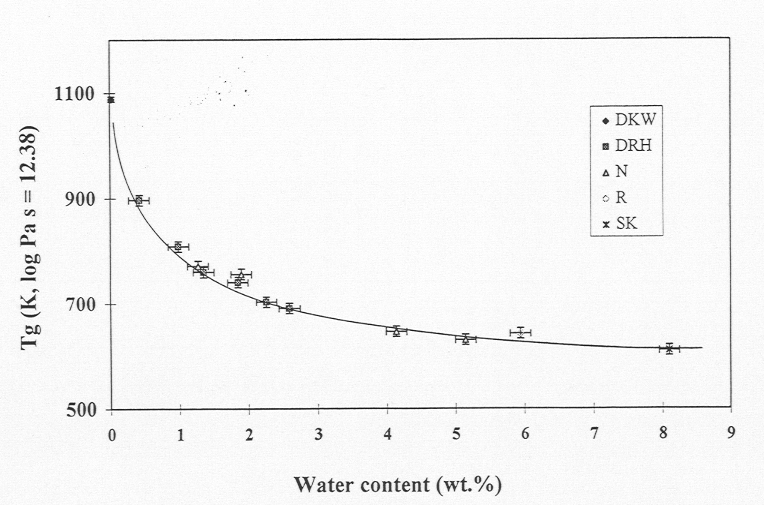

Reliable prediction of the glass transition temperature of hydrous granitic/rhyolitic liquids is of considerable importance for evaluating the potential role of the brittle-ductile transition in magma rheology and concommitant changes in the extensive thermodynamic properties of magmatic systems.
The influence of water on the glass transition temperature of hydrous granitic melts is estimated on the basis of a variety of available sources of data that provide phenomenological information for the liquid-glass transition and for which the relaxation timescale can be accurately estimated. These sources include (a) dilatometric micropenetration viscosity determinations, (b) temperature-dependent spectroscopic investigations of hydrous melts, and (c) densities of synthetic fluid inclusions in glasses. All available evidence on the glass transition temperature of hydrous granitic melts, when corrected for equivalent timescales, yields a single consistent trend of decreasing Tg with increasing water content that has powerful applications for understanding the rheology and kinetics of processes involving late-stage silicic intrusives and eruptive products. The brittle-ductile transition in hydrous silicic liquids can be accurately predicted using this trend.
The glass transition temperatures obtained from viscometry, from spectroscopic investigations, from scanning property determinations or from synthetic fluid inclusion in glass (SFG) studies must all be referred to the intrinsic relaxation time corresponding to the effective heating or cooling rate in those experiments.
For the present comparison a reference viscosity of log10 η (Pa s) = 12.38, corresponding the viscosity at the glass transition for a cooling rate of 5K/min, was chosen as the isokom (line of constant viscosity) of comparison for the various estimates of glass transition temperature. Viscosity data were extrapolated using established viscosity-temperature relationships, whereas the glass transition temperature estimates from spectroscopic and from volumetric studies were shifted in temperature to correspond to the 12.38 isokom using the activation energies of viscosity obtained for hydrous granitic melts at this range of viscosity.
The various experimental sources of glass transition temperature data for silicic melts compiled in Table 3.8-1 are plotted in Fig. 3.8-9 corrected to a quench rate of 5K/min corresponding to a viscosity at the glass transition of log10 η =12.38 Pa s. This isokom of viscosity defines a smooth and strongly non-linear decrease in glass transition temperature from over 1100 °C for dry granitic melt to less than 400 °C for water rich melts (6-8 wt% H2O). This remarkable fluxing effect of water is similar in magnitude and form to the effects of excess alkali oxides on the glass transition temperature of peralkaline silicic melts. It is described to within a standard error of the fit of ±10 K by an equation of the form
where Tg is the glass transition temperature at the log10 η (Pa s) = 12.38 isokom and cH2O is the water concentration in wt%. The standard error is similar in magnitude to the uncertainty in Tg obtained by some of the methods contributing data to Fig. 3.8-9 and thus the fit to the data and the agreement of various determinations of Tg with one another is excellent.
 |
|
|
 |
Fig. 3.8-9: The influence of water on the glass transition temperature (Tg) of hydrous granitic melts. This comparison corresponds to effective constant cooling at a rate of 5K/min corresponding to a viscosity at Tg of log h (in Pa s) = 12.38. The strong decrease of Tg with water content is highly non-linear. It has been fitted within error to equation. The data sources are listed in Dingwell et al. (1996, PEPI, in press). |

Tel: +49-(0) 921 55 3700 / 3766, Fax: +49-(0) 921 55 3769, E-mail: bayerisches.geoinstitut(at)uni-bayreuth.de
 Previous page
Previous page